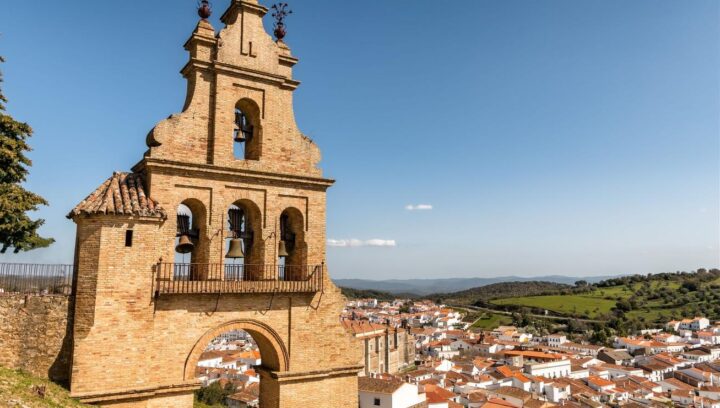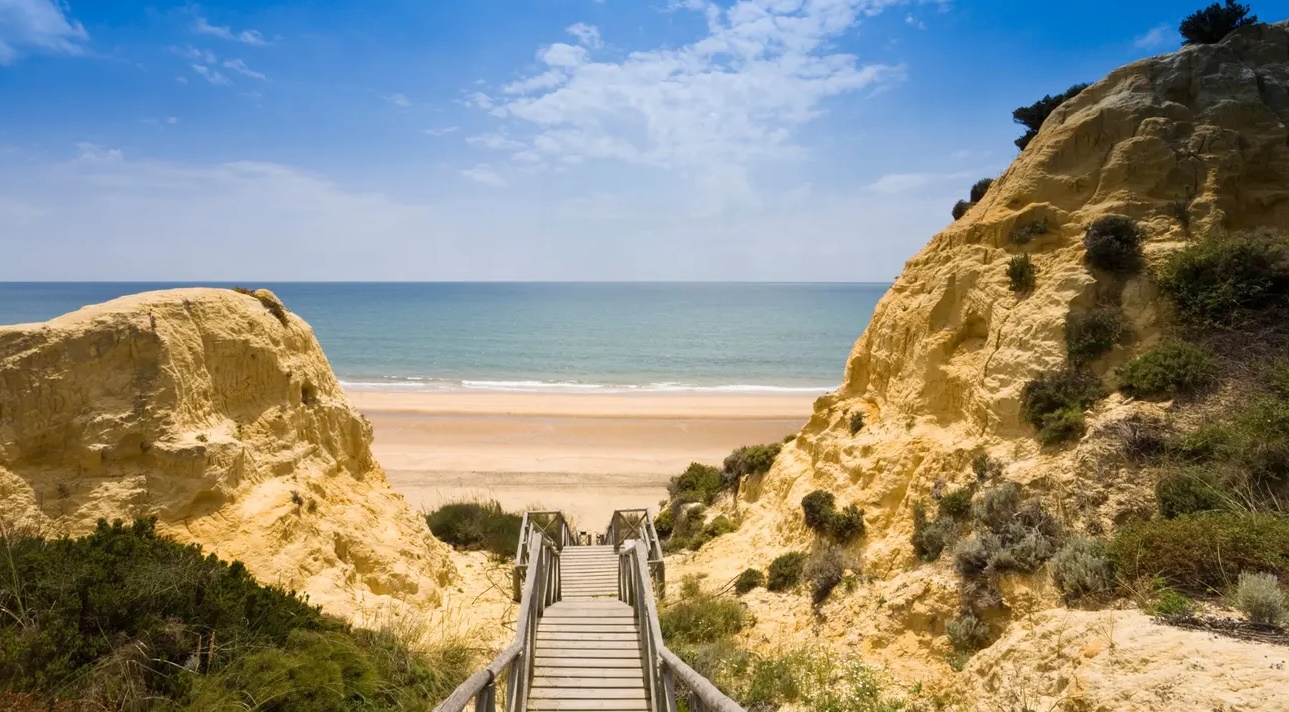
Huelva Travel Guide: Huelva Tips
Huelva: City & Province in Spain. Sights, Activities & Beaches / Huelva Travel Guide: Huelva Tips
Little known to holidaymakers, Huelva is a city and province in the Spanish region of Andalusia. Sitting between the border with Portugal to the west and Cádiz to the east, it is just 75 minutes from the Andalusian capital, Seville. A good reason to stop by and visit the Costa de la Luz at the same time.
Huelva: Overview
Come with us on a journey to the extreme southwest of Spain, to the Atlantic! Huelva is a city from which Christopher Columbus set sail and discovered America. Another special feature of the town, which has around 150,000 inhabitants, is the Barrio Reina Victoria, which was a former workers’ settlement of the English mining company Rio Tinto Company Limited. The Marismas del Odiel nature reserve and the Coto de Doñana national park await nature lovers. Those who pack their bathing suit can go swimming on the beaches and those who want to stop by Portugal for a short time only have to drive for three quarters of an hour to cross the Guadiana river on the border.
Sightseeing features
Usually, the place is always looked at intensively before further actions follow. It’s no different in Huelva. We present worthwhile things in the city and province. Stay tuned for what’s to come and what you can look forward to!
Muelle de Rio Tinto & Paseo de la Ría
Muelle del Tinto was once where the mining company Rio Tinto Company Limited loaded mined ore, but today the pier is used by anglers and walkers to enjoy the view of the surrounding area from Odiel. In the western direction you can see salt pans, among other things. Find a place that appeals to you and let your feet dangle over the water while you watch the sunset in the evening, for example.
Another place to stroll leisurely, pause and sit on a bench to take in the atmosphere is Paseo de la Ría, a leafy boulevard also on Odiel, beginning south of the pier described above.
Monumento a la Fe Descubridora & Casa de Colon
The Monumento a la Fe Descubridora (German “Monument for the Discovering Faith”), also called Monumento a Colón, indirectly reminds of the Italian discoverer Christopher Columbus. It was erected in 1929 at the confluence of the Río Tinto and the Odiel. The monument, donated by the United States, was intended by the sculptor to represent a seafarer who directs his visionary gaze to the west. The stone work of art is 37 m high.
The Casa de Colón (English “Columbus House) opened as a hotel in 1883, is now owned by the city and is used for events. You will find the representative building not far from the main train station. Because the tourist information is located there, you know where to turn if you want personal advice.
Muelle de las Carabelas
Strictly speaking, Columbus did not sail towards America from Huelva, but from Palos de la Frontera on the other side of the Río Tinto. To mark the 500th anniversary of the discovery of the New World, replicas of the ships Pinta, Niña and Santa Maria were made, displayed at the 1992 Expo in Seville and later brought to the spot where the long voyage began. It is hard for some of us to imagine that in the past there were people who embarked on adventures with unknown outcomes in such small ships. The well from which water was drawn for the journey still exists today.
Barrio Reina Victoria
The cityscape of Huelva changed significantly when the Rio Tinto Company Limited was granted permission in 1873 to extract the ore from the Riotinto mines. As a result, a railway station and loading dock were built on the Odiel. Then, in 1914, the Bario Reina Victoria district was born, giving the impression of being in 19th-century England. The houses housed the workers and employees of the mining company. By the way: In addition to the change that the activity of the Rio Tinto Company Limited brought to the city, only the earthquake in Lisbon in 1755 was more formative: In principle, Huelva had to be completely rebuilt at the time.
Museums in Huelva
In the pretty little town of Aracena, in the very north of the province of Huelva, the gourmets among you have the opportunity to go to the Museo del Jamón (English “ham museum”). Livestock farming plays a major role around Aracena, located in the Parque natural de Sierra de Aracena y Picos de Aroche. On site, you can also visit the castle and admire the Gruta de las Maravillas.
If you don’t want to drive to just before the northern border of Andalusia, you can also examine the Cueva del Zancarrón de Soto (German “Dolmen of Soto”) not far from Huelva. Those interested in archeology can walk through illuminated chambers and satisfy their curiosity in an information center. The dolmen was discovered in 1922 and its origin is estimated to be between 3000 and 2500 BC.
Those who don’t want to leave the provincial capital can explore art, ethnology and archeology at the Museo Provincial de Huelva.
Ermita del Rocio
A visit to the Ermita del Rocío can be easily combined with a detour to the Coto de Doñana National Park, as this is directly adjacent to the town. El Rocío should be known to one or the other religiously inclined person as a place of pilgrimage. At Pentecost, a particularly large number of believers arrive and the sandy squares and streets are full of carriages and horses. Many a vacationer may think they are in a town in the Wild West. The rest of the year it is relatively empty, then there are mainly national park visitors in El Rocío, as there is a visitor center here.
Plaza de las Monjas
The Plaza de las Monjas in the historic city center is a good place to take a break from strolling the streets and stop for a café. Observe the hustle and bustle around you and turn your attention to the fountain and the bronze monument to Columbus, which is three meters high and stands on a four and a half meter stone base. The Iglesia de Las Agustinas borders the square, behind it lies the Monasterio de Santa María de Gracia MM Agustinas. The latter was destroyed in the Spanish Civil War in 1936 and rebuilt in 1955.
Activities in Huelva
After a certain amount of sightseeing, most vacationers are ready for a change of pace in the form of activities. Find out what else Huelva has to offer in the following section. First things first: you won’t get bored!
Parks in Huelva
Parallel to the Odiel and a little further north of the pier, you can relax a little in Zafra Park and process the impressions gained while sightseeing. There is a pond with a fountain and sculptures line the paths, which are interspersed with lawns and hedges.
Alternatively, head to Parque Moret, which is more centrally located in the city and is said to be the largest urban park in Andalucia. In it you will find a skate park, children’s playground and barbecue areas. In addition to walkers, you can also see people using the paths as running tracks. On the larger of the two ponds there is the option of rowing a boat.
nature experiences
South of Huelva, the Marismas del Odiel nature reserve is home to many birds. The wetland is popular with migratory birds in winter, including spoonbills, herons, black and purple herons, black storks and flamingos. The native plants include kermes oaks, cistus and rosemary. Reeds, cattails and rushes can also be seen. To the recreational ornithologists: don’t forget your binoculars!
Between Huelva to the west, Seville to the north and Cádiz to the east lies the country’s most important wetland, the Coto de Doñana National Park. In addition to the plants and birds that also occur in the Marismas del Odiel, there is the Iberian lynx, an animal species that is threatened with extinction. Fallow deer can also be found. The wetland is fed by the waters of the Rocina and Guadalquivir rivers on land.
Go partying
If you still have energy at the end of the day, you can hit the town’s pubs and discos. In the evening and at night you can still have fun on Martín Alonso Pinzón and Alameda Sundheim Boulevard, in Plaza de Toros de La Merced or in the Isla Chica district, to name just a few options.
The Best Beaches in Huelva

The nearest beach is Playa El Espigón south of the Odiel estuary. It takes about 25 minutes to get there by car from the city center. The beach is three and a half kilometers long and has no tourist infrastructure whatsoever. Dogs are allowed on some sections of the beach. It is very windy, the sand is coarse in places and there are many shells. Anglers try to catch fish. If you don’t mind the industrial port at the back and you mainly want to be among the locals, you’re in good hands on this natural beach. You won’t be able to worry about a lack of space.
Huelva Travel Info
If you can hardly wait to start your holiday on the Costa de la Luz and visit a city that tourists tend to be less aware of, then read our travel information carefully before booking. So you are well prepared.
The easiest way to get to your destination is via Seville Airport. There are direct flights from Munich that cover the distance in less than three hours. Huelva, to the west of the Andalusian capital, can be reached by car (for example by rental car) in an hour and a quarter, covering a little over 100 km. If you prefer to travel by train, it takes an hour and a half, conveniently without changing trains.
Best time to visit Huelva
In April, May and October the temperatures are 20 °C to 24 °C, the first and last month are also the rainiest months of the year. There is hardly any precipitation in June, July and August, when it is almost too hot for some holidaymakers at 28 °C to 31 °C. The wind on the beach is all the more pleasant. The coldest month is January with 15 °C. The water is coldest in February and March, when it is 17 °C. From June to September there is the best weather for swimming at 23 °C to 24 °C.
Food & Specialties
There is no shortage of delicious food and drink in Huelva. You can enjoy air-dried beef or ham or choose from a wide range of fish and seafood. The range extends from tuna, sea bream, meager fish to sole, swordfish to crabs, lobsters, clams and squid. Palm hearts and strawberries (the province of Huelva is where most strawberries in Spain are grown) produce the soil.
Here are a few dishes that you can order in the restaurants:
Almejas a la marinera (seaman’s style clams)
Habas con choco (broad beans with squid)
Gambas al Ajillo (prawns with garlic)
Migas de Pan (bread with potatoes, red peppers and onions)
Raya en Pimentón (ray with peppers)
A local drink is ponche colombino, which is an alcoholic beverage made from white wine, sugar, peach, cinnamon, cloves, and a secret ingredient. It was invented in 1929.
Hotels & Accommodation
The number of hotels is manageable because Huelva is not a typical tourist region. However, it is possible to choose between accommodation from two to four stars, so that different available budgets and requirements are served.
Murcia Travel Guide: Murcia Tips
Girona travel tips: An idyllic alternative to Barcelona
Blue flag award: The cleanest beaches in Mallorca
Categories: General
